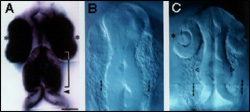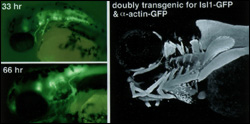 |
In study of neural differentiation, the conventional biochemical technique which starts with a large amount of material to purify the substance that manifests the physiological function in question is hardly valid. It was as late as in the eighties that the technology for overcoming or avoiding these problems was worked out. Progress was made in two aspects, (1) inventions of innovative technologies such as monoclonal antibodies and gene cloning, and (2) the simplification of experimental systems using culture systems and model experimental animals.
|
 |
|
These two strategies worked as the two wheels of a cart, making it possible after 1990 for scientists to solve the mysteries of developmental neurobiology at the molecular level, which had until that time remained unsolved. Particularly, it has become possible to identify and analyze differentiation factors and genes which function in a very small number of specific cells, firstly by the establishment of techniques using invertebrates such as Drosophila (fruit fly) and C. elegans (worm) for isolating mutants that present morphological or behavioral abnormalities, and secondly by identifying the affected gene using a molecular genetic technique.
|
- |

magnified scene by clicking image
|
|
As a result of comparative studies into the many genes identified in this way, an astonishing conclusion has been drawn. In developmental process of the vertebrate brain including the one of the human being, the same molecules and basic principles as those utilized in the development of fruit flies and worms are involved. The same group of genes that determine what kind of structure (e.g. wings or legs) will emerge from the body of a fruit fly determine where and how the cranial motor neurons grow in the human brain. It was also discovered that, in both the human being and the fruit fly, activation of the same genes triggers the formation of the eyes. The accumulation of such discoveries has enabled us to tackle a variety of issues that are peculiar to individual animal species somewhat paradoxically based on the universal principles that are applicable to all animals regardless of the species.
To address the issues of developmental neurobiology that are peculiar to vertebrates including the human being, the vertebrate experimental model animal that enables research at the same resolution as those achieved by using the fruit flies and worms has long been in quest for.
|
 |
The zebrafish is one of the tropical fish that is easiest to breed, and the adult female bears 50 to 200 eggs at a few days interval. The embryo grows very rapidly and completes development in 2-1/2 days after fertilization, when the water temperature is 28.5 。C (compare this to the human embryo, which takes 9 months and 10 days to develop). The zebrafish embryo is transparent almost throughout the development period. As a result, by using a type of microscope called differential interference microscope, it is possible to observe each and every neuron in the brain of a living zebrafish embryo. The baby fish grows up to become a sexually mature adult fish in 2 or 3 months (while the human being takes 20 to 30 years to do this, even from an optimistic viewpoint). Thus, the zebrafish is particularly suitable for genetic experiments.
|
 |
|
With the aid of such advantages of zebrafish, our laboratory investigates the mechanisms of formation of the cerebellum, which plays an important role in the control of motion, and the optic tectum that is the center of vision. It also studies the mechanisms by which the motor and sensory neurons extend their axons along specific pathways. The research is conducted with a full command of the latest molecular genetic technologies, for example by creating a cDNA library from trace amounts of tissues or by screening the mutant strains using transgenic fish in which the motor neurons are fluorescently labeled.
Our experience in zebrafish research has shown us that the zebrafish brain is quite similar to the human brain (though the difference in the development of the cerebral cortex is certainly distinct). If you ever try to catch a zebrafish with a net, you will find out very quickly how clever this animal is. It is almost incredible that zebrafish and the human being started to trace different roads of evolution hundreds of millions of years ago.
|

magnified scene by clicking image
| Fig. 2 | Joint research with Dr. Shin-ichi Higashijima,
PRESTO, JST |
|
- |
We expected that our research would not only enlighten us as to the basic principles of brain development that are common both in zebrafish and the human being, but also show us the essential reasons why our brain has become different from the zebrafish brain. With such a hope in mind, we are every day conducting our research while entrusting our biggest dream to this tiny fish.
|
 |
 |
 |
|
|
|






